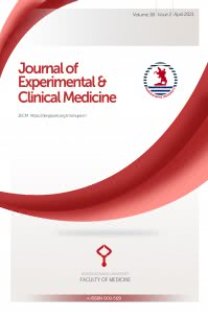Soliter pulmoner nodüllerin malign-benign ayrımında dinamik kontrastlı BT incelemesi
Coin lezyon, pulmoner, Tanı, ayırıcı, Tanı teknikleri, solunum sistemi, Tanısal görüntüleme, Akciğer neoplazmları, Duyarlılık ve özgüllük, Tomografi, x-ışınlı bilgisayarlı
Dynamic contrast enhanced computed tomography in malign-benign differentiation of solitary pulmonary nodules
Coin Lesion, Pulmonary, Diagnosis, Differential, Diagnostic Techniques, Respiratory System, Diagnostic Imaging, Lung Neoplasms, Sensitivity and Specificity, Tomography, X-Ray Computed,
___
1. Meschan I, Pugatch RD. Radiology of nodular lesion of lung parenchyma. In: Meschan I, ed. Roentgen sign in diagnostic imaging, Volume IV. 1st ed. Philadelphia: WB Saunders. 1987: 489-569.2. Swensen SJ, Jett JR, Payne WS, et-al. An integrated approach to evaluation of the solitary pulmonary nodule. Mayo Clin Proc 1990; 65: 173-186.
3. Zerhouni EA, Stitik FP, Siegelman SS, et al. CT of the pulmonary nodule: a cooperative study. Radiology 1986; 160: 319-327.
4. Proto AV, Thomas SR. Pulmonary nodules studied by computed tomography. Radiology 1985; 156: 144-153.
5. Huston JI, Muhm JR, Solitary pulmonary opacities: Plain tomography. Radiology 1987; 163: 481-485.
6. Swensen SJ, Brown LR. Colby TV, et al. Pulmonary nodules: CT evaluation of enhancement with iodinated contrast material. Radiology 1995; 194: 393-398.
7. Swensen SJ, Brown LR, Colby TV. et al. Lung nodule enhancemenL at CT: Prospective findings. Radiology 1996; 201: 447-455.
8. HeitzmanER. Bronchogenic crarcinoma:
9. Nathan MH, Collins VP. Adams RA. Differentiation
10. Jain RK, Gerltnvski LE. Extravascular transport in
12. Deffebach ME, Charan NB, Lakshminarayan S, eL normal and tumor üssues. Crit Rev Oncol Hemalol al. The bronchial circulaLion: small, but a vital 1986; 5: 115-170. . attribule of the İung. Am Rev Respir Dis 1987; 135:
11. Ziclinski KW. Kullng A. Zielinski J. Morphology of 463-481.
399. 405.
- ISSN: 1300-2996
- Yayın Aralığı: Yılda 4 Sayı
- Başlangıç: 2018
Soliter pulmoner nodüllerin malign-benign ayrımında dinamik kontrastlı BT incelemesi
Murat DANACI, Hüseyin AKAN, Ümit BELET, Lütfi İNCESU, Murat BAŞTEMİR, Mustafa Bekir SELÇUK
Multivaryatif oluşum içeren bir kafatası
Mehmet Ali ÇAN, AHMET KALAYCIOĞLU, ZELİHA KURTOĞLU OLGUNUS
Hodgkin dışı lenfomalı olgularda Ca-125 düzeyinin değerlendirilmesi
Mustafa KETENCİ, İdris YÜCEL, Murat TOPBAŞ
Toksoplazma antikorlarının Samsun yöresinde seroprevalansının araştırılması
Murat HÖKELEK, Yavuz UYAR, Murat GÜNAYDIN, Meryem ÇETİN
Bakan Nurten AKPOLAT, Tülin GÜMÜŞ, Ülkü AYPAR, Elif BAŞGÜL, MERAL KANBAK, Kemal ERDEM
Çalışanlarda yüzeyel mikoz prevalansı ve etken mantarların belirlenmesi
Ayhan PEKBAY, Ahmet SANIÇ, Ayla YENİGÜN, BORA EKİNCİ, Satı ATİLLA, Evren KOSİF, Figen ÖZCAN
Kallus distraksiyon yöntemi ile alt ekstremite uzatma sonuçları
YILMAZ TOMAK, Nevzat DABAK, T. Nedim KARAİSMAİLOĞLU, Mustafa KARA, Hakan ÖZCAN
